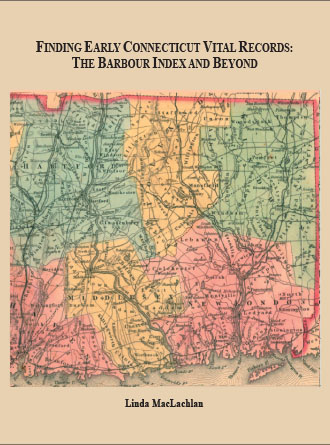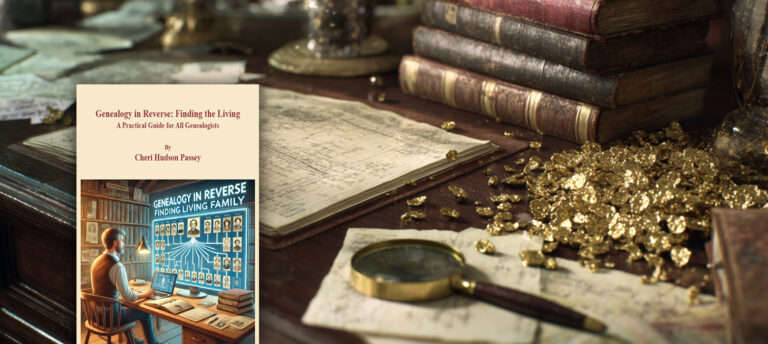
High Praise for Finding Early Connecticut Vital Records, by Linda MacLachlan
Last fall, we announced Linda MacLachlan’s book, Finding Early Connecticut Vital Records: The Barbour Index and Beyond. The product of a 10-year examination of Connecticut vital records, this work identifies the original sources of the millions of early Connecticut vital records abstracted in the Barbour Index. It names hundreds of books, manuscripts, and articles not referenced by Barbour, and points the researcher to thousands of additional sources for early Connecticut births, deaths, and marriages. Finding Early Connecticut Vital Records is, in fact, a veritable inventory of Connecticut vital records.
The reviews for Finding Early Connecticut Records are now coming out, including ones from the two of the most discerning periodicals in America, The American Genealogist (TAG) and The New England Historical and Genealogical Register (The Register). We have reproduced the review from the April-Oct 2019 issue of TAG below and will share The Register’s review with our readers in a later issue of “Genealogy Pointers.” If you have Connecticut ancestry and have not as yet purchased your copy of Mrs. MacLachlan’s book, you don’t have to take our word for it. Just listen to what reviewer Nathaniel Lane Taylor has to say about it.
158 The American Genealogist [April/July/October]
Finding Early Connecticut Vital Records: The Barbour Index and Beyond, by Linda MacLachlan (Baltimore: Clearfield, 2019), soft cover, 8.5 x 11″, xvi+345 pp., $49-95 ($75.00 hardcover), plus shipping and handling and applicable sales tax. Order from Genealogical Publishing Company, 3600 Clipper Mill Rd., Suite 229, Baltimore, MD, 21211; (800) 296-6687; genealogical.com.
The three southern New England states saw systematic compilation of early vital records (from colonial settlement to the mid-nineteenth century) on a town-by-town basis, from the 1890s to the Second World War. Rhode Island led the way: James N. Arnold published Vital Record of Rhode Island in twenty-one volumes from 1891 to 1912. In Massachusetts, over two hundred volumes of early town vital records were published from 1902 to 1936 (still known as the “tan books” for the color of their covers). In Connecticut, Lucius Barnes Barbour, Connecticut Examiner of Public Records, oversaw the indexing of vital records for one hundred and thirty-seven towns, compiled into typescripts in the 1920s. James N. Arnold, the veteran of the R.I. project, contracted with Barbour for the much of the Connecticut effort. (The resulting Barbour index was produced simultaneously as a set of town typescripts and as an all-state card index; see below.) The Barbour town typescripts were not printed then, but were typeset and published by the Genealogical Publishing Company in fifty-five volumes beginning in 1995.
Too many researchers dip into these published vital record series without properly understanding their limitations, and without making use of opportunities to go beyond them. Linda MacLachlan’s book, Finding Early Connecticut Vital Records: The Barbour Index and Beyond, is designed to encourage intelligent use of the “Barbour Collection” and to facilitate additional research. At three hundred and fifty pages, this goes well beyond the vital-records information in the eight-page town-by-town table in the Connecticut chapter of Genealogist’s Handbook for No England Research (currently in its 5th edition, edited by Michael J. Leclerc), or even the town-by-town summaries in Jeannie Sherman’s “Connecticut Town Guides: Compiled from Collections at the CT State Library” (PDF, Connecticut State Library [CSL], 2016, available at the CSL’s website). Of course, these other two guides also cover sources beyond the vital records.
Linda MacLachlan ‘s book consists of a general introduction followed by chapters for each Connecticut town, and a concluding section that brings together some finding aids for related resources at the CSL and a discussion of several anomalous drawers of record slips from various sources (including, notably, the town of Montville), housed with the Barbour card index but not recompiled into the Barbour town typescripts. The introduction, and the beginning of each town’s finding aid in this book, make it clear that the books published since 1995 are inferior to the 1920s typescripts, not only because some towns did not reappear in the 1995 series, but because the introductions in the 19208 typescripts—describing the original town records abbreviated and cited in that town’s index entries—were mostly omitted from the 1995 series. There is therefore no scholarly reason to cite the 1995 books, since they are wholly but imperfectly derived the 1920s typescripts, and thus are another generation removed from the original records The 1995 series however, has wide currency since it is indexed and imaged at Ancestry (to paid subscribers).
The 1920s Barbour town typescripts are available as scanned images at FamilySearch [FHL films 0967-2893], and are viewable and searchable through the index interface at americananccstors.org. These FHL images, however, are restricted to viewing at a Family History Center or affiliate library (“FHC-locked”)—this limitation is not mentioned by MacLachlan—while access at American Ancestors is to paid members only. In practical terms, researchers working from home then have a choice of paid access either to the 1995 series at ancestry.com or to the 1920s typescripts at americanancestors.org; the latter is the better choice. But furthermore, those consulting the Barbour town typescripts need to know that the all-state card index, created as part of the compilation process, contains many records not appearing in the town volumes, so should also be consulted. The whole card index is also available at FamilySearch [FHL films #2887-2996 and 2984], but again, these films are FHC-locked. MacLachlan also points out that the card index at the CSL was filmed for the Family History Library in 1949, but it continued to be added to well after that date.
Due diligence, then, requires searching the Barbour card index as well as the appropriate town volumes. But due diligence really requires going to the original records in Connecticut towns—always the intended purpose of the Barbour index, which, like Arnold’s Vital Record of Rhode Island but unlike the Massachusetts tan books, cites volume and page of the original manuscripts for every record entry. Many of those original town records have now been filmed, and some, unlike the Barbour collection, are unlocked and publicly available on FamilySearch. MacLachlan has made an effort to identify the FHL film numbers (or CSL call numbers, if no FHL filming was done) of original town records indexed and cited by Barbour, as well as additional sources—church records, cemetery inscriptions, etc., usually printed in boldface—not indexed by Barbour. MacLachlan’s bibliographies are frequently punctuated by interjections about ambiguities or problems, for example the semi-rhetorical question “Could there be another [record book] at the town hall?” inserted in a discussion of incomplete East Lyme record manuscripts on p. 101. Some source manuscripts are illustrated with A photograph of the spine, presumably to aid disambiguation (example: the spine of copy of the first volume of Voluntown vital records at the CSL, not filmed by the FHL, p. 287).
This book bears the aura of a work in progress, with a feeling of typographical chaos in the town bibliographies, and some question about the durability or utility of the finding aids in the appendix. But even as is, it is enormously helpful and clarifying; will be of vital use to Connecticut research. It can also be a model for similar efforts in other New England states, where old publications or indexes can now be supplemented with wide access to original vital records increasingly available online. I hope there may be a revised edition of this book in due course, but I expect to make good use of this one.
—Reviewed by Nathaniel Lane Taylor




